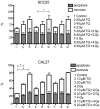Effect of thymoquinone on head and neck squamous cell carcinoma cells in vitro: Synergism with radiation
- PMID: 28693287
- PMCID: PMC5494754
- DOI: 10.3892/ol.2017.6189
Effect of thymoquinone on head and neck squamous cell carcinoma cells in vitro: Synergism with radiation
Abstract
Thymoquinone (TQ) is the main bioactive constituent present in black seed oil (Nigella sativa); it has shown anti-inflammatory and anti-neoplastic effects in various cancer cell types. The aim of the present study was to investigate the effects of TQ on head and neck squamous cell carcinoma (HNSCC) cell lines, on its own and in combination with radiation and cisplatin, respectively. The SCC25 and CAL27 HNSCC cell lines were treated with TQ alone and in combination with cisplatin or radiation, respectively. Proliferation assays and clonogenic assays were performed. Apoptosis was detected by flow cytometry. TQ exhibited dose-dependent cytotoxicity via apoptosis in the investigated cell lines. In combination with cisplatin, TQ resulted in no significant increase in cytotoxicity. Combined with radiation, TQ significantly reduced clonogenic survival compared with each treatment method alone. TQ is a promising agent in the treatment of head and neck cancer due to its anti-proliferative and radiosensitizing properties. However, the combination of TQ with cisplatin showed no therapeutic benefit in vitro.
Keywords: cisplatin; head and neck squamous cell carcinoma; radiation; radiosensitizer; thymoquinone.
Figures




References
-
- Al-Ali A, Alkhawajah AA, Randhawa MA, Shaikh NA. Oral and intraperitoneal LD50 of thymoquinone, an active principle of Nigella sativa, in mice and rats. J Ayub Med Coll Abbottabad. 2008;20:25–27. - PubMed
-
- Wiltfang J, Grabenbauer G, Bloch-Birkholz A, Leher A, Neukam FW, Kessler P. Evaluation of quality of life of patients with oral squamous cell carcinoma. Comparison of two treatment protocols in a prospective study-first results. Strahlenther Onkol. 2003;179:682–689. doi: 10.1007/s00066-003-1143-8. - DOI - PubMed
-
- Bieri S, Bentzen SM, Huguenin P, Allal AS, Cozzi L, Landmann C, Monney M, Bernier J. Early morbidity after radiotherapy with or without chemotherapy in advanced head and neck cancer. Experience from four nonrandomized studies. Strahlenther Onkol. 2003;179:390–395. doi: 10.1007/s00066-003-1077-1. - DOI - PubMed
LinkOut - more resources
Full Text Sources
Other Literature Sources
